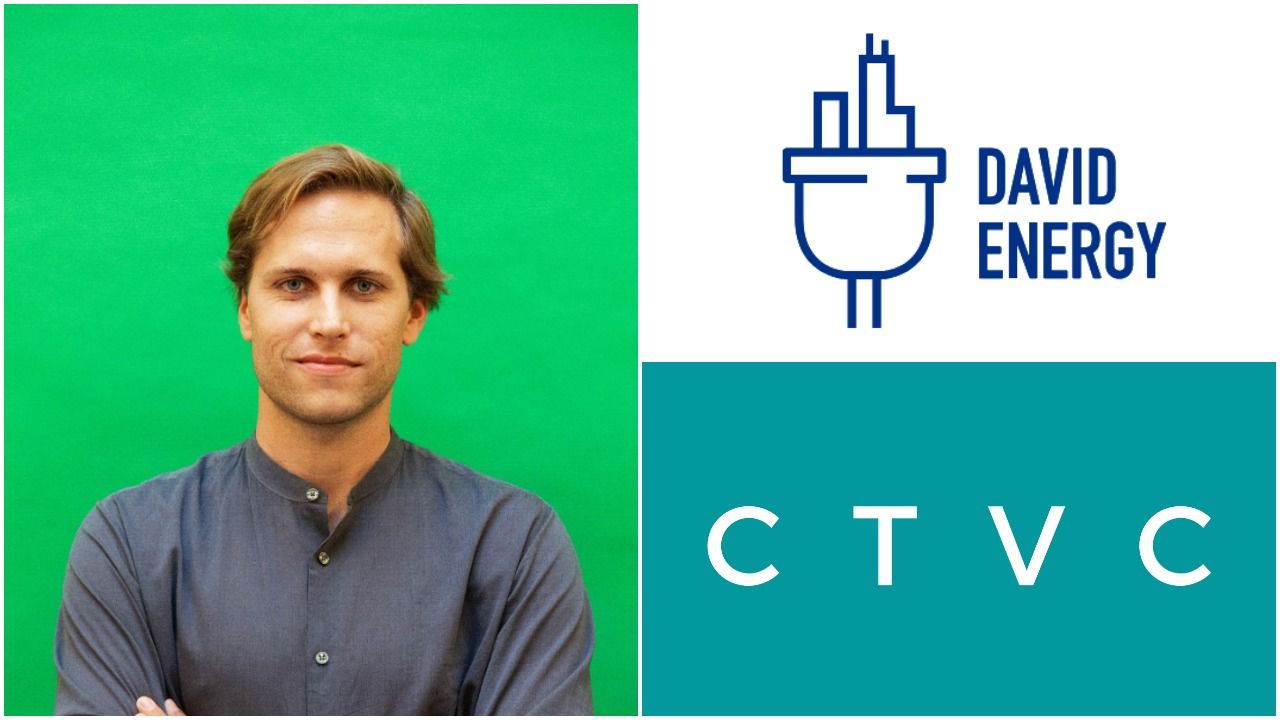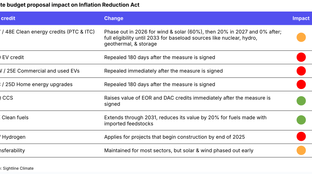
🌎 Overheard at LCAW #252
Climate, capital, and carrots in London's new playbook
A Q&A with David Energy's James McGinniss and Tesla’s crypto tailpipe
Happy President’s Day and Chinese New Year!
In a somber note, Greentech Media announced last week that it was shutting down. As avid readers and fans, we’re grateful to GTM for their inspiration, education and continued support of smarter climate understanding. They’ve helped carry the torch and inspired a generation of folks looking to get to know their changing world a smidge better.
As Kanye would say, what’s one to do with all that power? In this week’s Valentine’s feature, we profile James McGinniss and David Energy - not unlike Cupid, they’re taking aim at consumers that love saving, cleaner energy, resilience and agency. To take down the ‘Goliath’ power providers, they’re leveraging DERs (generators, Nests, etc.) to create a bi-directional energy marketplace that lets consumers use energy smartly and avoid the price and production volatility that has become all too common in a shifting climate.
We also cover a range of deals, from Imperfect Foods most recent financing to big banks cutting a deal for green commodities trades, as well as the recent spate of catalytic converter snatches.
Thanks for reading! Now go enjoy those half-price Reeses’.
Not a subscriber yet?
Last week, Tesla announced that it bought $1.5b worth of Bitcoin and will start to accept Bitcoin as payment, driving up the cryptocurrency’s already sky-high price by another 20%. As the poster child for clean green driving machines, Tesla’s decision to purchase Bitcoin is an interesting trade given the carbon intensity of bitcoin production. As bitcoin rallies, the argument is that more computing power will be spent ergo increasing the carbon sink of generating more crypto-reward.
Fast facts about the energy and emissions implication of crypto mining:
⚡️ A Bitcoin energy consumption dashboard from the University of Cambridge posted a “theoretical upper bound” of 50GW peak consumption globally (when all mining happens at once). For context, California’s peak load is ~63GW.
📈 A recent study estimated that Bitcoin alone is responsible for around 22m tonnes of carbon dioxide emissions annually – greater than the carbon footprint of the country of Jordan.
There’s a handful of ventures trying to minimize the negative energy impact of bitcoin, though none change the fundamental mining calculus as it exists today:
🏠 Mighty Buildings, an Oakland, CA-based homebuilding startup using 3D printing, robotics and automation to produce sustainable and affordable homes, raised $40m in Series B funding from Khosla Ventures, Zeno Ventures, Bold Capital Partners, and ArcTern Ventures. More here.
🚗 Vulog, a France-based provider of shared mobility solutions, raised $31m in funding from the European Investment Bank, Frog Capital, ETF Partners Inven Capital and BpiFrance. More here.
🍎 Imperfect Foods, a San Francisco, CA-based company delivering otherwise discarded groceries, raised $15m in additional Series D funding from Hamilton Lane and Blisce. More here.
💨 C-Zero, a Santa Barbara, CA-based startup decarbonizing natural gas, raised $11.5m in Series A funding from Breakthrough Energy Ventures, Eni Next, Mitsubishi Heavy Industries and AP Ventures. More here.
💵 Manifest Climate, a Toronto, Canada-based cleantech software startup, raised $6.5m in Seed funding from Klass Capital, Golden Ventures, OMERS Ventures, Bryker Capital, Garage Capital, Active Impact Investments and several high net worth investors. More here.
⚡ David Energy, a Brooklyn, NY-based electricity supplier, raised $4.1m in Seed funding from Equal Ventures, Operator Partners, Box Group, Greycroft, and MCJ Collective. More here.
🐮 Hoxton Farms, a UK-based startup producing cell-based animal fats, raised $3.7m in Seed funding from Founders Fund, Backed, Presight Capital, and others. More here.
💵 Tickr, a UK-based investing app in the ESG space, raised $3.4m in Seed funding from Ada Ventures. More here.
Volta Industries, a San Francisco, CA-based electric vehicle charging network, will go public via merger with SPAC Tortoise Acquisition II, a SPAC, valuing the business at $2b. More here.
Hyzon Motors, a Rochester, NY-based maker of hydrogen fuel cell powered commercial vehicles, will go public via merger with SPAC Decarbonization Plus Acquisition, valuing the firm at about $2.1b. More here.
Loop Energy, a Vancouver, Canada-based fuel cell company, filed for an $100m IPO. More here.

This week we sat down with James McGinniss, CEO and Co-Founder of David Energy, to learn more about distributed energy resources (DERs) and how David Energy plans to transform the Goliath electricity grid. Described by Bloomberg as “a new kind of energy company,” David Energy is a retail electricity supplier that leverages customer’s onsite energy assets such as smart thermostats, batteries, and EVs into electricity markets. By intelligently adjusting customer demand in real-time via these assets, David Energy is able to deliver cheaper and cleaner electricity contracts than incumbent suppliers. Fresh off a new $4.1m Seed raise and $15m working capital facility announced last week, we sat down with the chief slingshotter himself. [We’ve edited the newsletter version lightly for length; visit our website for the full feature].
What are DERs? How are they changing the way the energy market functions?
DER stands for Distributed Energy Resources. They’re a broad bucket of devices such as generators, solar batteries, smart thermostats, electric water heaters, and heat pumps. Any energy device that’s installed in a home or building is distributed in nature – either producing, storing, or controlling energy.
As we integrate more solar and wind into the supply-side of energy, customers on the demand-side need to be much more responsive and flexible because clean energy availability fluctuates. We view DERs as part of the key suite of technologies that will allow us to adopt a highly renewables-dependent grid.
Many customers in the US are completely new to having a choice over their energy retailer. What does an “energy retailer” do and how are retailers different from utilities?
There is a lot of confusion around the difference between utilities and retailers.
On one side of the energy market, you have wholesale. Generators, like big power plants, bid their power in at a certain price. On the other side of the market, you have retail energy providers that sign contracts with customers for that power (i.e., they buy power on behalf of customers). Retailers ship the energy on wires and infrastructure that are typically owned by utilities – causing most people to think that utilities are their power provider. Confusingly, in certain cases they can be. Across 20 states with “de-regulated markets,” retailers are allowed to provide power, not just vertically-integrated utilities. In deregulated markets, providers send power on utility wires that they don’t own just like UPS and Amazon ship packages on roads.
What approach does David Energy take? And how does David Energy stand out from traditional retail providers?
Our name “David Energy” comes from the story of David and Goliath. We want people to be able to make their own decisions about where they get their energy. Our mission derives directly from what DERs provide: cleaner, cheaper, more resilient, and empowering energy. We hope this amounts to a massive cultural awakening in energy, where people have preferences on which companies they get their energy from, as well as a shift in the perception of what an electricity provider is.
Traditional retail energy providers and utilities operate like Goliath on a massive scale of gigawatt-magnitude coal, nuclear, and hydro plants and with limited software. They buy power in one location and sell it elsewhere, taking a margin on the spread between the two and using utility infrastructure to ship the electricity from location A to B. The explosion of DERs like smart thermostats, battery storage, heat pumps, electric vehicles, advanced backup generators, and smart meters means much more data but also potential for individual customer control of the grid. We saw a massive divide between customers with DERs and the traditional power providers who didn’t know how to serve them.
We’ve built a technology platform that integrates with and controls these DERs. As a vertically-integrated company, where we are also the retail electricity and demand response provider, we’re able to leverage those assets directly in the wholesale market and provide our customers cheaper power. We have granular visibility into customer demand, which we can shape in real time using the DERs to be smarter about how to get power from the market.
For example, power prices are generally ~$30/MWh day to day, but on the hottest days in Texas prices can go up to $9,000/MWh. These 300x price surges are happening more frequently (like, right now!) with climate change (e.g. in California during wildfires). In these high price moments, David Energy can tell a battery to discharge, auto-adjust thermostats, and delay an EV from charging until later to generate cheaper rates for the customer. We built David Energy to be a vertically integrated model combining the software with being a retail energy provider so customers get one simple, all-in-one product.
What challenges keep traditional energy providers from being able to do what you do?
The primary challenge is that energy is extremely commoditized. Everyone buys from the same 10 power desks and has the same access to the market every day. It’s hard to have an edge on price. Typically, for a $80/MWh deal the retailers might differ in price by $0.50-$1.00, which the customer hardly cares about. They’re having a tough time switching to a service-based approach because (1) they’re not especially software savvy and (2) they built their business model around old methods of buying and selling power. For these power sellers, customer acquisition and churn are high which they can’t really fix.
We also expect to start buying power from some of our customers. If they are using solar, for example, we can buy back excess power and funnel it to our other customers. Currently, energy retailers are allergic to solar customers. They use a one-way model of the grid, so they’re confused how to sell the excess solar power. We’re building our model around a bidirectional grid and offering customers a service instead of just a power contract.
What’s David Energy’s customer proposition?
Our product offering isn’t just a cheaper power contract, but also enables more transparency around energy bills and real-time controls, bringing the whole suite of energy operations under one roof. We see DERs provide four distinct values to customers:
Tell us more about the FERC’s Order 2222 and its impact on DERs?
Currently, DERs are haphazardly compensated utility-to-utility. Some markets don’t even have demand response programs. Payment typically happens via what’s called net-metering, where the utility gives you credit for your exported excess power. Net-metering was a great tailwind for the market, but because the utility is the sole offtaker there’s a cap on the power consumed and produced.
The FERC ruling forces recognition of DERs as wholesale market participants for energy capacity and demand-response, and essentially pulls the DER compensation mechanism out of the hands of the utility. This is a huge tailwind for us and for the future of the grid we envisioned when we started David Energy. It’s all coming true right on schedule.
You just announced a highly anticipated Seed round! Congrats! Who participated in the Seed?
Thanks! We raised a $4.1m Seed led by incredibly knowledgeable Rick Zullo at Equal Ventures who - despite being a software VC - is a real energy market expert! Additional seed investors include Operator Partners (led by Zach Weinberg and Nat Turner), BoxGroup, Greycroft, Sandeep Jain and Xuan Yong of RigUp, returning angel investor Kiran Bhatraju of Arcadia, and Jason Jacob’s MCJ Collective rolling fund.
How does the $15m working capital facility from Hartree Partners support the equity Seed round?
We’ve signed a working capital facility with Hartree – which is a wholesale power desk. We are essentially buying hedges through the power desk. They are then lending us that power, and eventually we will pay it back to that power desk when the customer pays us. This is the backbone of every retailer, because there is a ton of cash turnover every month venture capital equity should not be used to fund. It was important to find a group that is aligned with us on the future of energy markets (i.e., bidirectional flow). So they’re really a partner, not just a lender.
Curious about how you too can wield the slingshot? David Energy is hiring a VP of Engineering. To explore partnership opportunities, reach out here. Those curious to dive deeper into IOT connected energy devices are welcome to join the DER Task Force, which James organizes. Lead investor, Rick Zullo at Equal Ventures, open sourced an insight studded deep dive into DERs prior to investing.
Wood Mackenzie has shuttered greentechmedia.com and GTM Squared, as it consolidates its clean tech insights and analysis on woodmac.com. The move left many in the industry confused about the timing.
The White House announced a new Climate Innovation Working Group aiming to put together an ARPA-C program and a $100m funding opportunity for research on DAC, carbon capture, net-zero buildings, and more. (Bonus photo: Zoom meeting with the climate gang)
A few weeks ago, Elon Musk tweeted about a $100m prize for the best carbon capture tech (and we followed up with a list of ideas). Now the prize has been formalized with XPRIZE.
It’s cold in Texas and they need power! Heating loads along with gas plant outages drove Texas electricity prices to hit their market price ceiling of $9000/MWh. If you can supply even 1 MWh of energy in Texas this weekend, you’d make thousands within minutes. Sounds like a ludicrous and lucrative opportunity...
Amazon announced its largest single renewable energy project yet, the Amazon-Shell HKN OffShore Wind Project will have an overall capacity of 759MW to supply the Netherlands.
Total is the next oil major in line to rebrand itself as an integrated energy company “TotalEnergies” - despite an expected portfolio of 50% gas, 30% oil, 5% biofuels, and 15% electrons by 2030 lacking real carbon neutrality ambitions.
Everyone loves a coupon, including commodities traders. Banks have extended discounted lines of credit to two of the world’s largest commodity traders, Trafigura Group and Gunvor Group, to finance low carbon raw materials trades.
Carbon credit developer, South Pole, adds biochar startup, Carbo Culture, to its portfolio as private sector demand for verified permanent carbon removals heats up.
Stripe opened up its second round of carbon removal purchases. Ryan Orbuch notes that “the carbon removal ecosystem, a field blocked on demand for years, may soon be blocked on supply”
Popeye was on to something … Spinach can send emails to scientists to alert them of climate changes.
Reading this in line for the ski lift? Check out these 12 technologies – from artificial clouds to indoor slopes – that could help ski areas weather warmer temperatures.
In his new role as Secretary of Transportation, Pete Buttigieg swerves from his passenger vehicle-loyalist predecessors saying “roads aren’t only for vehicles”.
What’s old could now become new in the fashion industry. Evrnu’s re-polymerization now allows brands to create fabrics out of recycled fibers.
Thieves are swiping catalytic converters off of cars for their rare metal value. Will their bounty shrink with more EVs on the streets?
💡 Norrsken Impact Accelerator: Early stage startups that align with the UN SDGs can apply by February 28th to be considered for Norrsken Impact Accelerator’s 8-week sprint.
💡 Techstars Sustainability Challenge: Startups addressing sustainable supply chains can apply by March 1st to connect with industry-leading corporate partners.
💡 Energy Tech Challengers: (formerly NEC New Energy Challengers) identifies the world’s top energy transition startups competing in 6 main tracks (batteries, hydrogen, e-mobility, digitalization, automation & AI, future grid) for prizes. Apply by April 1st.
🗓️ Stanford Energy Seminar: Tune in to Joe Powell’s talk on hydrogen's role in achieving net-zero carbon emissions.
Investment Analyst @Princeville Capital
Summer PortCo Internships @Elemental Excelerator
Head of Research Integration @Capital for Climate
Wholesale Origination Associate @Clearway
Data Science Engineer; Product Analyst @Weave Grid
Climate Data Scientist @McKinsey Climate Analytics
Carbon Project Manager @Apple
Chief Product Officer @Ecosia
Project Manager @Heila Technologies
Business; Product Designer @Watershed
Feel free to send us new ideas, recent fundings, or general curiosities. Have a great week ahead!

Climate, capital, and carrots in London's new playbook

US plays popcorn politics with biofuels and beyond

Groundbreaking results from the geothermal developer’s main project